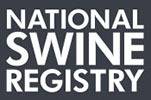We are often asked about breed qualifications of the 4 breeds of the National Swine Registry. Below is a summary of breed requirements and markings.
Durocs
Durocs should be red with down ears. If a Duroc has white on any part of its body, including its feet, it may be disqualified. It is okay for Durocs to have white on the end of their nose, as long as it doesn’t break the rim of the nose. They are not allowed to have more than 3 black spots and none over 2 inches in diameter on the body.
Durocs should be red with down ears. If a Duroc has white on any part of its body, including its feet, it may be disqualified. It is okay for Durocs to have white on the end of their nose, as long as it doesn’t break the rim of the nose. They are not allowed to have more than 3 black spots and none over 2 inches in diameter on the body.
Hampshires
Hampshires should be black with a white belt that goes completely around both front legs and feet. They are allowed to have some white on their nose, as long as it doesn’t exceed the rim of the nose. If the white goes under the pig’s chin, it cannot be more than what a U.S. minted quarter will cover. Hampshires can have white on their back legs, as long as it is only from the hock down. These color requirements must be met by Hampshire boars and gilts for them to be eligible to show in breeding events. If a Hampshire doesn’t have a full belt, it can still be bred and its offspring can be registered; however, it can’t be exhibited as a breeding animal at NSR shows.
Hampshires should be black with a white belt that goes completely around both front legs and feet. They are allowed to have some white on their nose, as long as it doesn’t exceed the rim of the nose. If the white goes under the pig’s chin, it cannot be more than what a U.S. minted quarter will cover. Hampshires can have white on their back legs, as long as it is only from the hock down. These color requirements must be met by Hampshire boars and gilts for them to be eligible to show in breeding events. If a Hampshire doesn’t have a full belt, it can still be bred and its offspring can be registered; however, it can’t be exhibited as a breeding animal at NSR shows.
Landrace
Landrace should be white with down ears and should not have colored hair on any part of their body. If a Landrace has large, colored spots or numerous colored spots on its skin, it is ineligible to be recorded.
Landrace should be white with down ears and should not have colored hair on any part of their body. If a Landrace has large, colored spots or numerous colored spots on its skin, it is ineligible to be recorded.
Yorkshires
Yorkshires should be white with erect ears and not have any colored spots larger than an U.S. minted quarter.
Yorkshires should be white with erect ears and not have any colored spots larger than an U.S. minted quarter.
Please keep in mind if any breed shows evidence of a third dewclaw, it is ineligible to be recorded. Durocs, Landrace, and Yorkshires should have at least a 6-6 underline to be recorded. Hampshires must have a 6-6 underline to be shown as a breeding animal, but can still be recorded if their underline is not 6-6.
I hope this helps clear up any uncertainties you may have. As always, let us know if you have any questions!
Whitney Hosier






